|
|
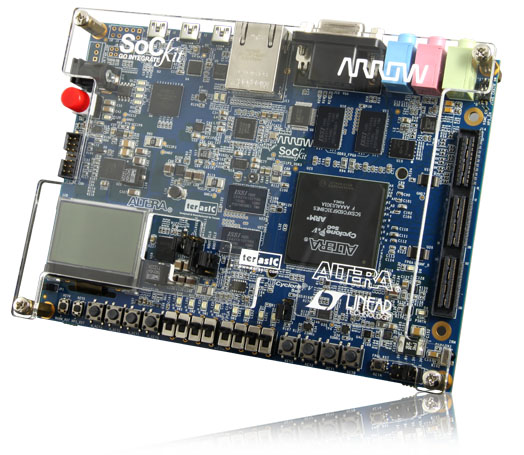
The SoCKit Development Kit presents a robust hardware design platform built around the Altera Cyclone V System-on-Chip (SoC) FPGA, which combines the latest Cortex-A9 embedded cores with industry-leading programmable logic for ultimate design flexibility. Users can now leverage the power of tremendous re-configurability paired with a high-performance, low-power processor system. Altera’s SoC integrates an ARM-based hard processor system (HPS) consisting of processor, peripherals and memory interfaces tied seamlessly with the FPGA fabric using a high-bandwidth interconnect backbone. The SoCKit development board includes hardware such as high-speed DDR3 memory, video and audio capabilities, Ethernet networking, and much more. In addition, an on-board HSMC connector with high-speed transceivers allows for an even greater array of hardware setups. By leveraging all of these capabilities, the SoCKit is the perfect solution for showcasing, evaluating, and prototyping the true potential of the Altera SoC. FPGA Device- Cyclone V SX SoC—5CSXFC6D6F31C6N
- 110K LEs, 41509 ALMs
- 5140 M10K memory blocks
- 6 FPGA PLLs and 3 HPS PLLs
- 2 Hard Memory Controllers
- 3.125G Transceivers
ARM®-based hard processor system (HPS)- 800 MHz, A Dual-Core ARM Cortex™-A9 MPCore™ Processor
- 512 KB of shared L2 cache
- 64 KB of scratch RAM
- Multiport SDRAM controller with support for DDR2, DDR3, LPDDR1, and LPDDR2
- 8-channel direct memory access (DMA) controller
Configuration and Debug- Quad Serial Configuration device – EPCQ256 for FPGA
- On-Board USB Blaster II (micro USB type B connector)
Memory Devices- 1GB (2x256MBx16) DDR3 SDRAM on FPGA
- 1GB (2x256MBx16) DDR3 SDRAM on HPS
- 64MB QSPI Flash on HPS
- Mini SD Card Socket on HPS
- EPCQ256 Flash on FPGA
Communication- USB 2.0 OTG (ULPI interface with micro USB type AB connector)
- USB to UART (micro USB type B connector)
- 10/100/1000 Ethernet
Connectors- One HSMC (8-channel Transceivers, Configurable I/O standards 1.5/1.8/2.5/3.3V)
- One LTC connector (One Serial Peripheral Interface (SPI) Master ,one I2C and one GPIO interface )
Display- 24-bit VGA DAC
- 128x64 dots LCD Module with Backlight
Audio- 24-bit CODEC, Line-in, line-out, and microphone-in jacks
Switches, Buttons and LEDs- 8 User Keys (FPGA x4 ; HPS x 4)
- 8 User Switches (FPGA x4 ; HPS x 4)
- 8 User LEDs (FPGA x4 ; HPS x 4)
- 2 HPS Reset Buttons (HPS_RSET_n and HPS_WARM_RST_n)
Sensors- G-Sensor on HPS
- Temperature Sensor on FPGA
Power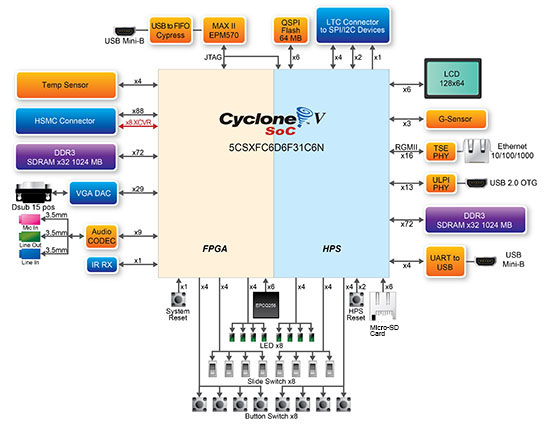
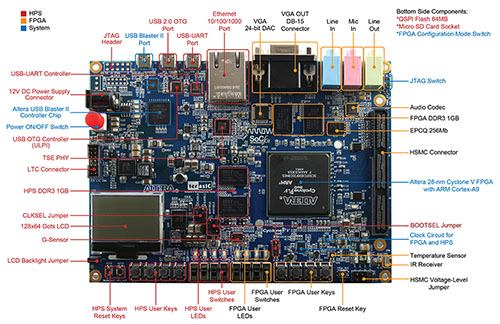
Getting HelpFor further discussion, support, and resources, please go to: Resources
Linux BSP (Board Support Package): MicroSD Card Image| Linux Image File | 3.12 | 4GB | 69MB | 2014-08-26 |  |
Support Daughter Cards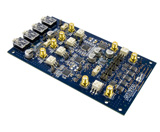 | AD/DA Data Conversion Card
The AD/DA Data Conversion Card was created to provide a set of Analog to Digital and Digital to Analog interfaces including an Audio CODEC interface. The High Speed Mezzanine Card (HSMC) can be used to develop DSP applications with Altera Development boards and Terasic Development boards (e.g.DE3) that feature the HSMC connector. View More |  | Highspeed AD/DA Card
The THDB_ADA (ADA) daughter board is designed to provide DSP solution on DE series and Cyclone III Starter Kit, or other boards with HSMC or GPIO interface. View More | 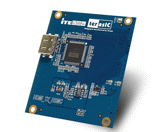 | HDMI Transmitter Daughter Card
HDMI_TX_HSMC is a HDMI transmitter daughter board with HSMC (High Speed Mezzanine Connector) interface. Host boards, supporting HSMC-compliant connectors, can control the HDMI_TX_HSMC daughter board through the HSMC interface. This HDMI_TX_HSMC kit contains complete reference design with source code written in Verilog and C, for HDMI signal transmitting. Based on reference designs, users can easily and quickly develop their applications. View More | 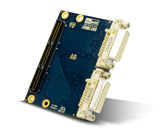 | DVI-HSMC Card
The Terasic DVI-HSMC is a DVI transmitter/receiver board with a High Speed Mezzanine Connector (HSMC) interface. It is designed to allow developers to access high quality and high resolution video signals that support UXGA Resolution (Pixel Rates up to 165 MHz). It gives the flexibility required in high resolution image processing systems by combining both the DVI transmitter and receiver onto the same card. Lastly, the DVI-HSMC daughter board can be connected to any HSMC/HSTC interface host boards. View More |  | GPIO-HSTC Card
The HTG Card is designed to convert a High-Speed Terasic connector (HSTC) or a High-Speed Mezzanine connector (HSMC) I/Os to three 40-pin expansion prototype connectors, which are compatible with Altera DE3/DE2-115/DE2/DE1/DE0 expansion headers. Users can connect up to three Altera DE3/DE2-115/DE2/DE1/DE0 boards (or associated daughter cards) onto a HSTC/HSMC-interfaced host board via a HTG Card. View More |
|
|
|
